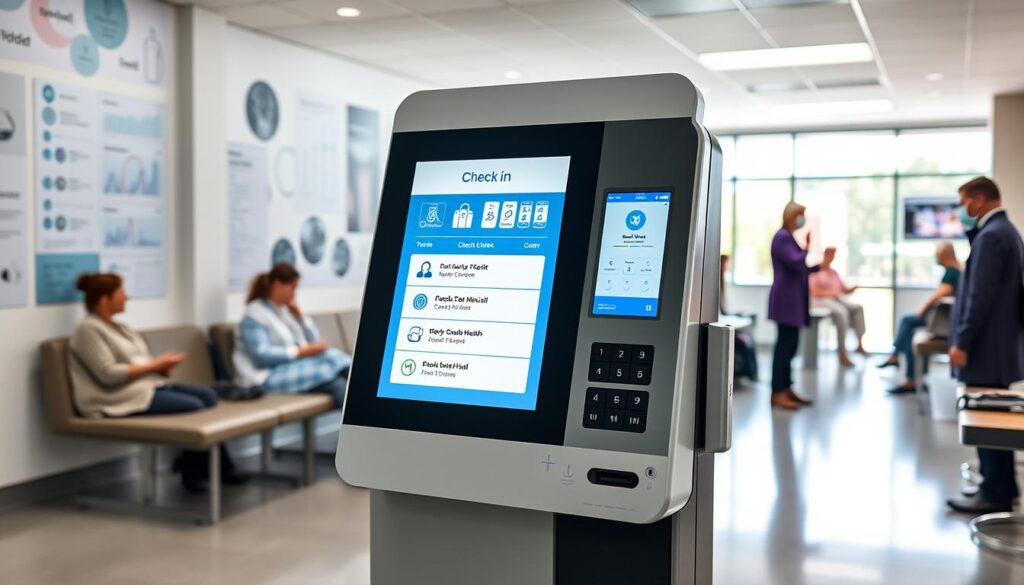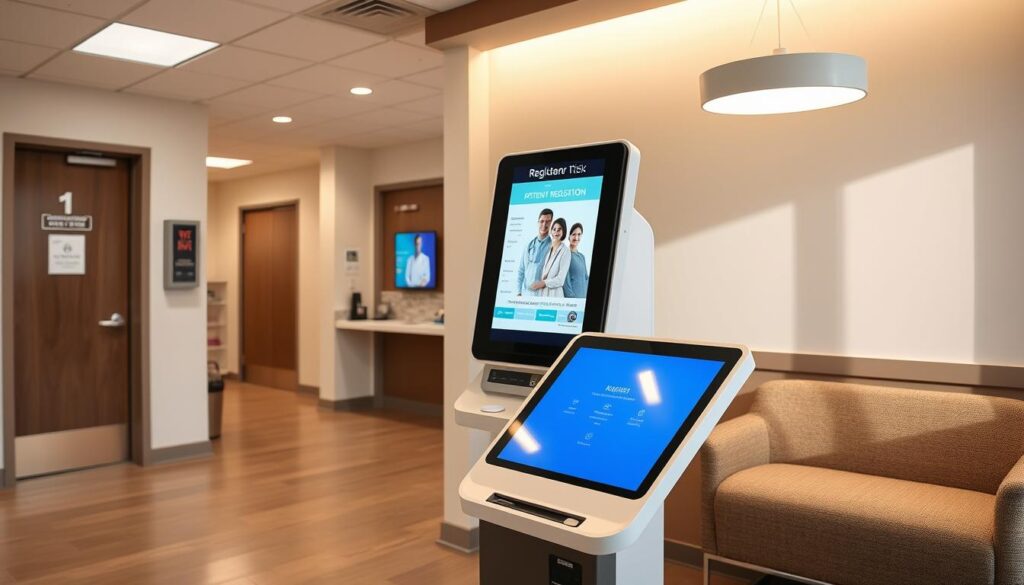Self-service kiosks are changing healthcare, making it more efficient and patient-friendly. These devices let patients manage their health care, from booking appointments to paying bills. They can even request prescription renewals.
These kiosks work with point-of-sale systems and hospital software. This has made managing daily operations easier. The use of these kiosks is growing fast, with a 16 percent increase expected in the next decade.

Key Takeaways
- Self-service kiosks in healthcare facilities can improve patient experience by displaying maps, emergency service numbers, and extensions.
- Patients’ control over tasks at self-service kiosks reduces perceived wait times and enables effective time utilization.
- Self-service kiosks streamline the check-in process, eliminating mismanaged queues and ensuring quick processing of patient information.
- Self-service kiosks offer faster and convenient payment capture by accepting multiple forms of payment, streamlining the financial journey for patients.
- Accessing medical records, test results, and prescription information through self-service kiosks enhances convenience and accessibility for patients.
Understanding Healthcare Self-Service Kiosks: Definition and Core Functions
Healthcare self-service kiosks are interactive screens that let patients do things on their own. They can check in for appointments or pay medical bills. These tools are changing how patients deal with healthcare, making things faster and better for everyone.
Basic Components and Features
At the heart of these kiosks are easy-to-use touch screens and software for patient check-in. They also have strong security and tools for payment and ID capture. Some kiosks even let patients have virtual doctor visits or do simple tests.
Integration with Hospital Management Systems
These kiosks work well with a hospital’s systems, keeping data up to date. This makes things run smoothly, from scheduling appointments to updating records. It helps make patient care better and more connected.
Types of Healthcare Kiosks Available
- Check-in kiosks: Let patients check in for appointments, update info, and check insurance.
- Payment kiosks: Make it easy and safe to pay for medical services, like copays.
- Wayfinding kiosks: Help patients and visitors find their way around the hospital with interactive maps.
- Telemedicine kiosks: Allow for remote doctor visits, making healthcare more accessible.
These kiosks help make healthcare faster and more efficient. They let patients be more involved in their care. This leads to happier patients and better work for healthcare teams.
The Role of Self-Service Kiosk in Healthcare: From Check-In to Payment
Self-service kiosks are now a big part of healthcare. They make the patient journey smoother from start to finish. These tools are key in making things easier for patients and improving healthcare.
One big plus of self-service kiosks is how they cut down on wait times. A study found they can cut check-in times by up to 50%. This makes patients happier and lets doctors and nurses do more important work.
These kiosks also help make sure patient data is right and safe. Patients can put in their own info, cutting down on mistakes. Plus, they use strong security to protect patient privacy.
Another benefit is how they make paying easier. Patients can see how much they owe and pay right away. This makes managing money for healthcare places better.
“Self-service kiosks have revolutionized the healthcare industry, empowering patients to take control of their healthcare experience while streamlining administrative processes for providers.”
Self-service kiosks also help patients feel more involved in their care. This makes patients happier and leads to better health results.
In short, self-service kiosks do a lot in healthcare. They help with check-in, payment, and more. They make things easier for patients and help healthcare run better, leading to happier patients and better health.
Streamlining Patient Check-In and Registration Process
In healthcare, the patient check-in and registration process is key. It sets the tone for the whole patient experience. Self-service kiosks are changing this step, making it smoother and more efficient for everyone.
Automated Data Collection and Verification
Self-service patient registration kiosks let patients update their info, medical history, and insurance details. This automated data collection and verification cuts down on staff work. It ensures records are accurate and up-to-date.
Queue Management Solutions
Self-service kiosks come with queue management solutions. They help manage patient flow and reduce wait times. This makes the patient experience better and boosts operational efficiency.
Digital Form Completion and Signature Capture
Self-service kiosks get rid of paper forms. Patients can fill out digital forms and sign electronically. This makes the check-in process faster and more accurate, reducing manual errors.
Using self-service kiosks in healthcare has shown great results. They can cut patient check-in times by up to 50%. They also make front office work 10% to 15% more efficient. Adding AI to digital healthcare solutions can make patient flow even better.

Self-service kiosks do more than just speed up check-in. They let healthcare providers focus on quality care. This improves patient satisfaction levels.
Enhancing Payment Processing and Financial Management
Self-service kiosks are key in making healthcare payments smoother and more efficient. They accept many payment types, like credit and debit cards, and cash. This gives patients the freedom to choose how they pay.
Kiosks show real-time payment details. Patients can see their balances, payment history, and upcoming bills. This helps them understand their healthcare costs better.
By automating payments, kiosks take a big load off healthcare staff. This lets them focus on more important tasks. It also saves money for healthcare places by cutting down on manual work and errors.
Kiosks help make billing clearer and more reliable. They check insurance, handle payments safely, and work well with hospital systems. This makes billing more open and trustworthy, which makes patients happier and more confident.
Kiosks are easy to use, so everyone can pay without trouble. They’re designed for people of all ages and abilities. This makes paying for healthcare easy and stress-free for everyone.
As healthcare payments and money management change, kiosks will become even more important. They help make healthcare better, more efficient, and more patient-friendly. By using these new tools, healthcare providers can give better care and improve their financial health.

Improving Patient Experience and Satisfaction Levels
Self-service kiosks in healthcare are key to better patient satisfaction and healthcare experience. They make things faster and more efficient. This means less waiting and a better hospital efficiency.
Reduced Wait Times and Enhanced Efficiency
Self-check-in kiosks let patients do tasks like filling out forms and paying without staff help. This makes the experience better and helps healthcare providers serve patients faster. Healthmark Group found their kiosk improves efficiency by saving time and making payments early.
Privacy and Confidentiality Benefits
Self-service kiosks also protect privacy and confidentiality. They let patients enter sensitive info privately. This makes patients feel safe and trusted in the healthcare system.
Accessibility Features for Diverse Patient Populations
- Self-service kiosks often have options in many languages, helping patients from different backgrounds.
- They also have features like adjustable screens for patients with different abilities, making healthcare more inclusive.
Self-service kiosks give patients more control over their healthcare. This leads to a better and more efficient experience. It can also make patients more loyal and likely to recommend the healthcare provider.
| Key Benefit | Impact |
|---|---|
| Reduced Wait Times | Streamlined check-in and administrative tasks, enabling healthcare providers to attend to patients more efficiently. |
| Enhanced Privacy | Confidential access to personal health information and secure payment processing, promoting trust and comfort. |
| Improved Accessibility | Multilingual options and adjustable features cater to diverse patient populations, ensuring an inclusive experience. |
| Increased Patient Satisfaction | Positive healthcare experiences lead to higher patient loyalty and likelihood of recommending the provider’s services. |
“Self-service solutions can deliver a more satisfying patient experience and also benefit a healthcare facility’s financial success.”
Cost-Efficiency and Resource Optimization for Healthcare Facilities
Self-service kiosks in healthcare have made a big difference. They automate tasks, saving on staffing costs. This lets healthcare teams focus on more important work. Plus, they cut down on paper and printing costs by digitizing forms and info.
The cost to set up kiosks can be $2,000 to $10,000 each. But, the long-term savings and efficiency gains make them worth it. Kiosks help make healthcare operations smoother and cheaper, leading to better healthcare cost reduction, resource management, and operational efficiency.
| Metric | Improvement |
|---|---|
| Patient wait times | Decreased by 6 times |
| Administrative work for patient processing | Decreased by 2 times |
| Patient flow growth at kiosk terminals (first 5 months) | Steadily increased |
| Patients willing to switch healthcare providers for better experiences | 86% |
Self-service kiosks are a big win for healthcare. They make processes smoother and use resources better. This leads to a more efficient and patient-focused healthcare experience.
“Self-service solutions provided by SEDCO resulted in a significant improvement in patient flow, allowing patients to move easily between different facilities within the healthcare center.”
Conclusion
Self-service kiosks are changing healthcare by making it more efficient and patient-focused. They help with check-ins, payments, and improve data accuracy. These technologies are key in the digital change of healthcare.
Healthcare providers who use self-service kiosks lead in patient care. They meet today’s healthcare needs and give patients a better experience. Patients are happier, check-ins are faster, and data is more accurate.
By using self-service kiosks, healthcare places can save money and work better. Patients can also be more involved in their care. As healthcare keeps changing, self-service kiosks will be important. They will make healthcare better for everyone.
FAQ
What are self-servicing kiosks in healthcare?
Kiosk with self servicing features in healthcare are devices found in waiting rooms. They let patients book or reschedule appointments and check-in. Patients can also make payments and request prescription renewals using these kiosks.
What are the core functions of healthcare self-serve kiosks?
These kiosks help patients do things on their own. They can book appointments, check-in, and make payments. They also let patients access their medical records.
What are the different types of healthcare kiosks available?
There are several types of healthcare kiosks. These include check-in kiosks, payment kiosks, and wayfinding kiosks. Some advanced kiosks can even do simple tests or help with virtual consultations.
How do self-service kiosks streamline the patient check-in process?
Self-service kiosks make checking in easier. Patients can update their information and medical history on the kiosk. They also help manage patient flow, making wait times seem shorter.
They also eliminate the need for paper forms. This reduces administrative work and improves data accuracy.
How do self-service kiosks improve payment processing and financial management in healthcare?
Self-service kiosks accept various payment methods. This makes it easier for patients to pay. They also show real-time payment information, helping patients manage their bills.
By automating payments, kiosks save staff time. This makes healthcare facilities more financially efficient.
How do self-service kiosks improve patient experience and satisfaction levels?
Self-service kiosks reduce wait times and make check-in private. They offer features like multiple languages and adjustable screens for all patients. This makes healthcare interactions more positive and efficient.
How do self-service kiosks lead to cost-efficiency and resource optimization for healthcare facilities?
Kiosks reduce the need for staff in administrative tasks. They also cut down on paper and printing costs. While they may cost $2,000 to $10,000 each, they save money in the long run.